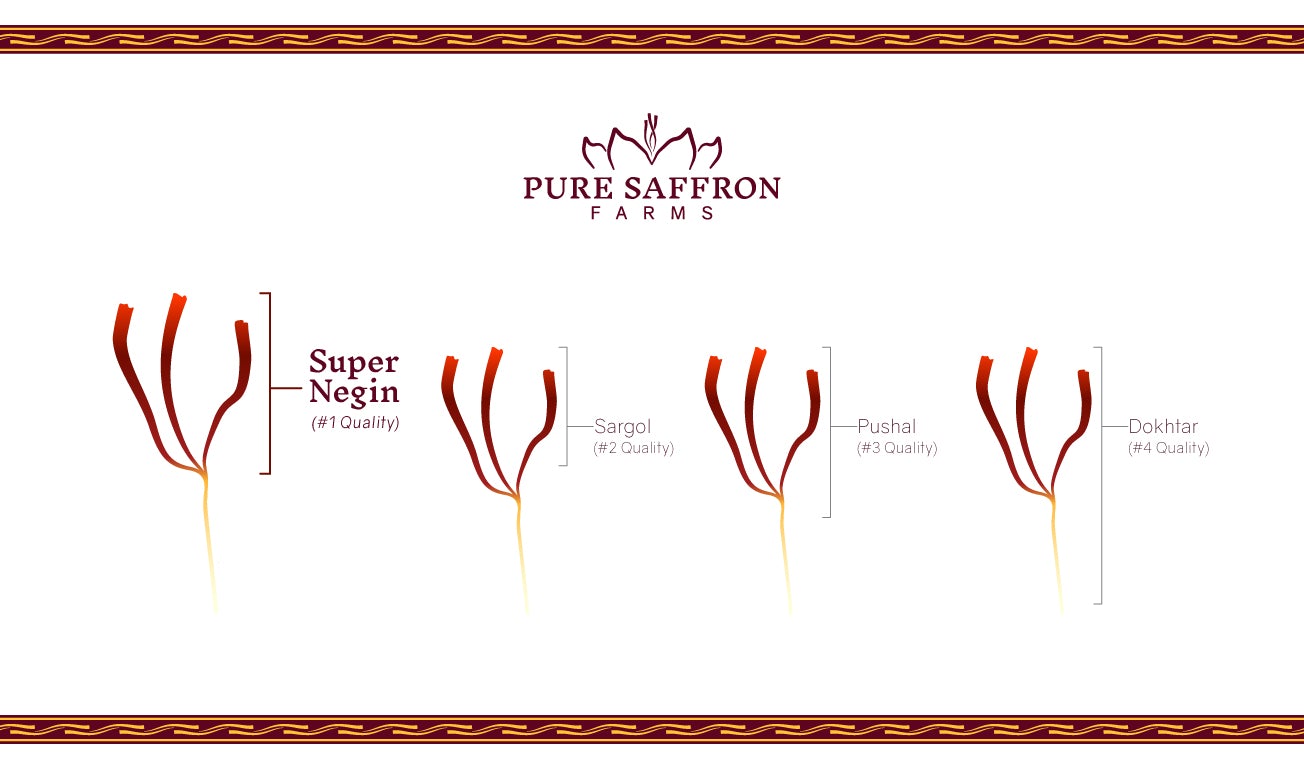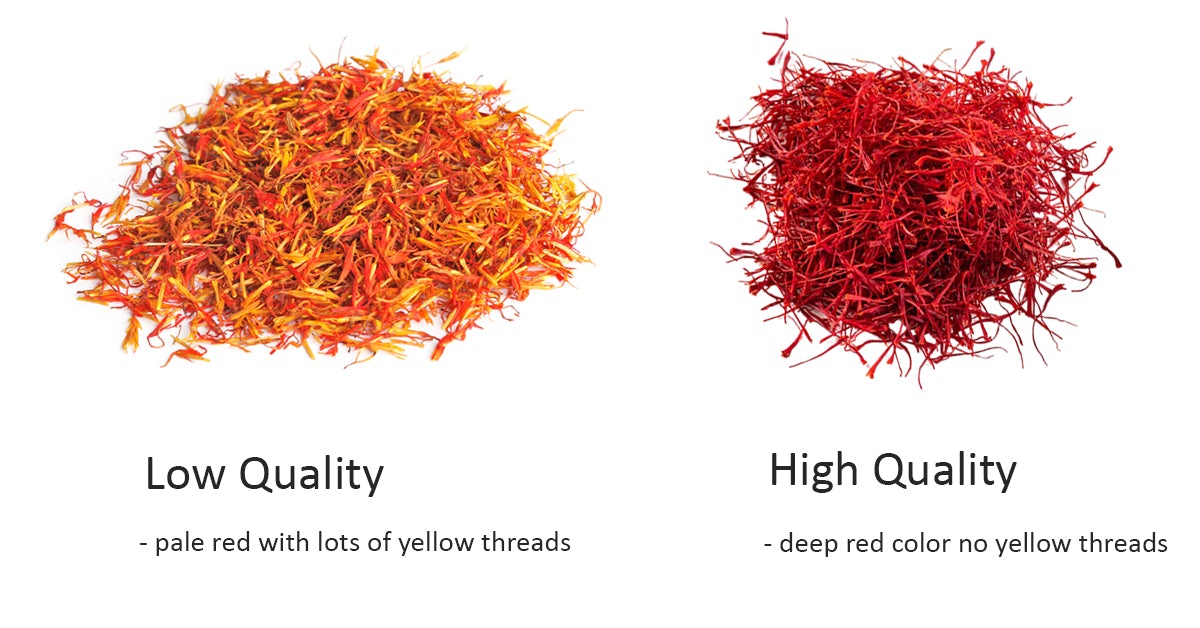Blogs
Learning the Different Grades and Qualities of Saffron
In this Article:
- All this saffron, what’s the difference?
- The different grades of Saffron
- Identifying quality saffron
- Identifying fake saffron
Reading time: Two and a half minutes
All This Saffron, What’s the Difference?
Saffron has four different grades to qualify how well the harvest is rated. These can vary greatly depending on the weather that year and the general geographic location. Top tier saffron can also be different depending on where the harvest was located; once you’ve tried a few different kinds, you will generally settle into one location you prefer. There are also fakes on the market, the pricing can be deceptive, some fakes can still charge top dollar to try and convince the consumer that it’s genuine. The quickest way to spot the difference between fake saffron and real, is to keep in mind that the saffron threads should be a deep dark red, and that it’s easier to fool a consumer with ground saffron powder.
The Different Grades of Saffron
Depending on who’s system we use, there can be up to four different grades of Saffron that range -as expected- from grade four, being the worst to grade one being the best. International grades are assigned via the international standards organization; the ISO grade is determined generally by three factors – color, flavor, and aroma. This is assuming the saffron meets basic quality standards to begin with. Measuring crocin, a chemical compound found in the saffron threads, is of primary concern because it’s strength effects all other outcomes of measurement. Below, we illustrate the four different grades of saffron quality.

Grade I – Super Negin – The good stuff, crocin heavy! Super Negin Saffron should be deep red, no shake (other parts of the plant) stigmas only, and dry. Each thread from the crocus should be 9.5mm in length (.375 inches) to 12.5mm (half an inch) long. Again, saffron from different regions, experiencing different growing conditions leaves a lot of personal interpretation each year as to what the very best saffron might be.
Grade II – Sargol – When the general public buys saffron they are most often buying sargol grade saffron. It’s quality varies according to the thickness of the stigmas and the presence or absence of broken stigma.
Grade III – Pushal – The third grade of saffron can contain deep red stigmas of high quality but to put it simply, it’s “cut” by not being… cut, precisely. Attached below the red stigma (thread) is the end bit of yellow or white connecting plant material.
Grade IV – Dokhtar – The lowest grade of saffron consists of your standard red stigma, but it’s connected to the whole “style”. Think of a flower’s style like a secondary flower stem which grows from inside the flower. Usually saffron is made from the very deep red top of this, lower grade saffron also includes the yellow or white bottoms.
What’s the difference between Super Negin and Sargol Saffron?
- Super Negin – At the beginning of the saffron flower harvest when the flower is fresh and not yet dried, the cream and yellowness of the saffron are immediately separated from the red stigma.
- Sargol – Sargol saffron however, is separated after the saffron dries. The cream from the stigma is removed at this point.
What does it mean? Simply – this causes Sargol saffron to have broken and smaller stigmas than Super Negin saffron.
Worldwide ISO classification, Persian Saffron, Greek Saffron and Spanish saffron all use different grades. However, for example, a Persian Saffron graded as “Sargol” (the most common, top end saffron export in countries like Iran) may also submit to gaining a secondary ISO rating to improve export marketability.
Identifying Quality Saffron
As we briefly touched on above, cooking with high quality saffron is really “The only way to go about life, son”. Being able to identify the quality of something you buy online or at your local market is definitely a key to your culinary success when cooking with saffron (other than proper portions).
A couple easy rules of thumb to keep in mind:
- Not mushy or damp; moisture is bad.
- Appropriately dried, with a length of at least 9.5mm in length (.375 inches)
- While it could be argued there is some use for lower grade saffron, generally when you’re going for that unique earthy flavor in your cooking you want to maintain purity. This means deep, dark reds. No yellows or whites.
- Avoid all but the most reputable vendors of saffron powder. This is the easiest to successfully adulter (fake!).
- Consider price. At the high end, saffron price could potentially be faked – for example, the buy price is quite high but the product is still fake or cut. This can’t happen at the lower end, however. No pure saffron supplier can afford to provide the product at “too good to be true” prices; HQ saffron selling at the lower price range is – trust us – simply too good to be true.
Shopping Online for Saffron
If your buying online, go ahead and contact the supplier for more information. Ask about the procurement process, the geographic specifics, or the ISO (and other appropriate) ratings. For your reference, you can contact Pure Saffron Farms here.
Identifying Fake (or Low Grade Saffron)

As above, low grade saffron will contain colors other than red and may be cut too short, or not as dry as a proper harvest should be from the saffron harvesting regions. Only the stigma (threads) should be present in your purchase and if it contains yellow threads this is the first indicator of low quality saffron.
Identifying outright fake saffron can be a little more challenging because, well, thieves can be a lot of things, but boring and unoriginal usually aren’t some of those things. There’s always a new way to game the system, but we can advise you of the “adulterating industry” standard.
The easiest way to turn the bad into the good, is to dye the outside of a stigma dark red. You can test your saffron in some water and observe how long it takes to fully permeate throughout the solution. Fake saffron is going to begin to interact with the water much faster.
Traditional tasty saffron needs to steep in the water some time to bring the flavors fully into play.
Saffron On, Friends!